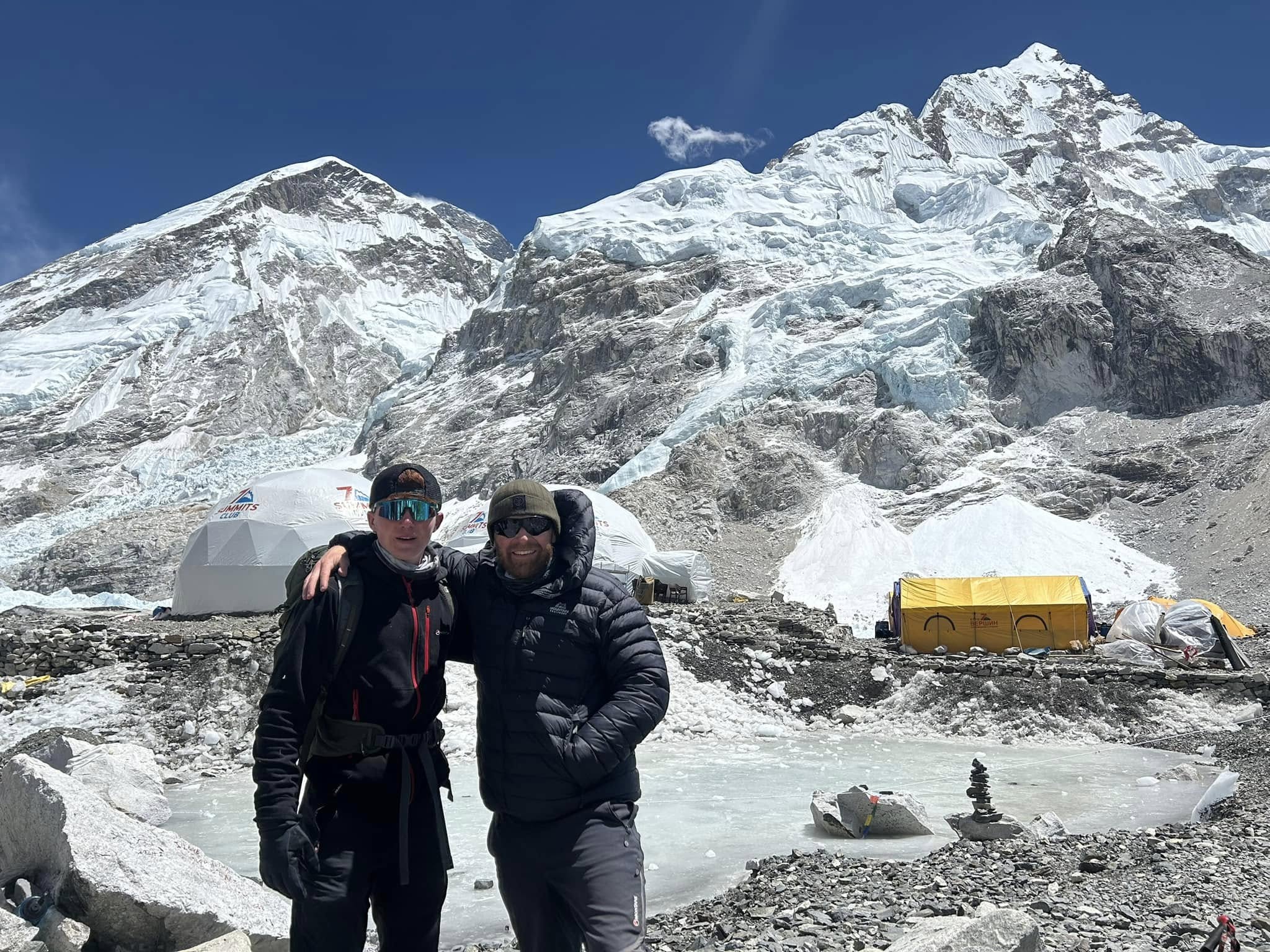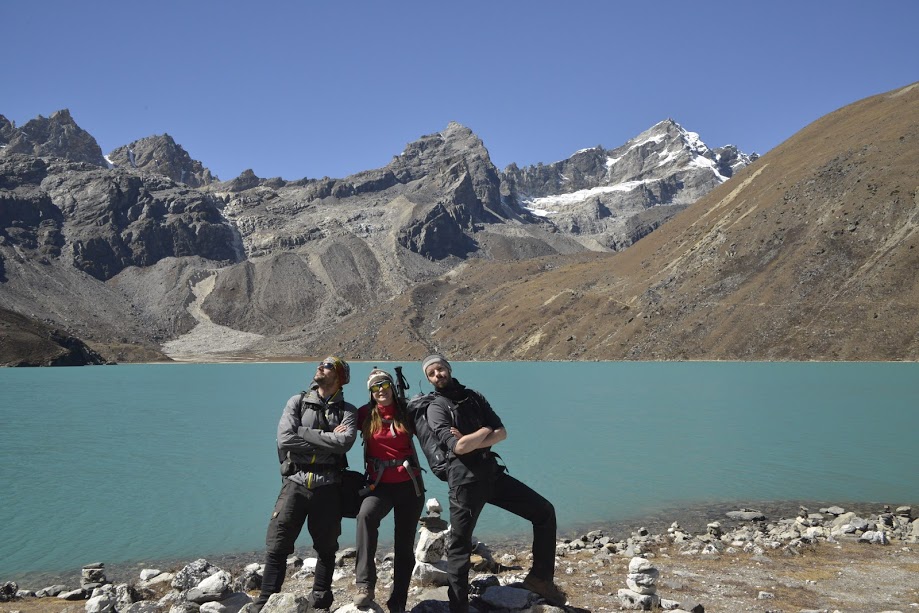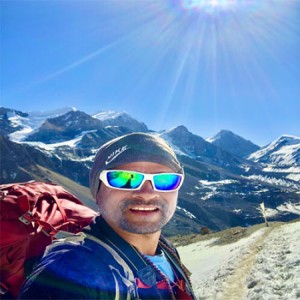How much does the Everest Base Camp trek via Gokyo Lakes and Cho La Pass cost?
The Everest Base Camp trek via Gokyo Lakes and Cho La Pass (18 days) typically costs between USD 1,599 and $1,789 when booked through a reliable local trekking company. The price varies based on group size, service level, and any added upgrades. This cost generally covers Kathmandu accommodation with breakfast, teahouse lodging during the trek, all meals on the trail, a licensed English-speaking guide, porter support, domestic flights, permits, and ground transportation.
If you prefer a customized EBC Gokyo trek, tailor-made itineraries are available—ideal for those seeking more flexibility, comfort, or cultural immersion. Add-ons like Lukla helicopter flights, upgraded lodging, or private transport will increase your total cost slightly.
We also offer group rates and customizable packages for the Gokyo Valley, Cho La Pass, and Everest Base Camp trek, ensuring value without compromising quality. Reach out to plan your perfect 2025/2026 Himalayan adventure.
Here’s a closer look at the key factors that influence the cost of this 18-day adventure:
1. Group Size: Trekking in a group can reduce the overall cost per person, as certain expenses—like guide and porter fees—are shared among participants.
2. Trekking Company: Different local agencies offer various packages depending on the level of service, accommodation type, and customization. Compare inclusions carefully when choosing your provider.
3. Permits and Entry Fees: You’ll need several permits, including the Sagarmatha National Park Permit (NPR 3000), the Khumbu Pasang Lhamu Rural Municipality Permit (NPR 3000), and a TIMS Card ($20 if traveling with a government-registered company).
4. Accommodation Options: Standard treks include basic teahouse stays, but premium packages may offer upgraded rooms with attached bathrooms or heating in key villages.
5. Meals and Beverages: Three meals a day are typically included in most packages. However, your food costs can vary depending on the region and your preferences for snacks or drinks.
6. Guides and Porters: Hiring a licensed guide and/or porter is recommended for safety and comfort. Their wages and insurance are usually included in full-service packages.
7. Flights and Transportation: A round-trip flight between Kathmandu and Lukla is essential for this route and is typically included in the package, though helicopter upgrades are available at an extra cost.
.jpg)
How Difficult Is the Everest Base Camp Trek via Gokyo and Cho La Pass?
The Everest Base Camp Trek via Gokyo Lakes and Cho La Pass is widely regarded as one of the more challenging treks in Nepal. It combines high-altitude hiking, long trekking days, and demanding terrain, making it best suited for experienced trekkers in good physical condition. This route reaches elevations well above 5,000 meters (16,404 feet). Notable high points include Cho La Pass at 5,420 m/17,782 ft and Kala Patthar at 5,545 m/18,192 ft. These extreme altitudes significantly increase the risk of acute mountain sickness (AMS), so proper acclimatization is crucial.
Trekkers typically walk 6 to 7 hours per day, navigating steep ascents, rocky trails, and at times, icy or snow-covered sections. The crossing of Cho La Pass is particularly demanding, often requiring crampons or traction aids, especially in winter and spring. This trek takes you through remote mountain regions with limited access to emergency services, and the weather can be unpredictable, potentially causing itinerary changes or delays.
To prepare, trekkers should focus on building cardiovascular endurance, leg strength, and mental resilience. While not mandatory, prior experience with high-altitude or multi-day trekking can greatly improve your ability to handle the trek’s challenges safely and confidently.
.jpg)
What is the best time to trek Everest Base Camp via Gokyo Lakes & Cho La Pass?
The ideal time to trek to Everest Base Camp via Gokyo Lakes and Cho La Pass is during the spring (March to May) and autumn (September to November) seasons. These months offer the most reliable weather, clear mountain views, and safer trail conditions—perfect for high-altitude trekking across the Khumbu region.
For the safest and most scenic experience, plan your Everest Base Camp trek via Gokyo and Cho La Pass in spring or autumn. These seasons offer the perfect balance of weather, visibility, and trail conditions for a memorable Himalayan adventure.
A: Spring (March to May):
This is a vibrant season with clear skies, blooming rhododendrons, and gradually warming temperatures. Mornings are typically bright, with great views of Everest, Lhotse, and Cho Oyu. While it’s one of the busiest times on the trail, it also provides excellent trekking conditions. Occasionally, brief storms or wind may cause minor delays, especially near high passes like Cho La.
B: Autumn (September to November):
After the monsoon, the skies clear up, offering crisp air, excellent visibility, and dry trails. This is the most popular trekking season, thanks to stable weather and incredible mountain views. Nights are colder, particularly above 4,000 meters, but daytime hiking conditions are very comfortable.
C: Winter (December to February):
Trekking is possible, but extremely cold temperatures, snow-covered trails, and icy conditions on Cho La Pass make it more suitable for experienced trekkers. Lodges may be closed at higher altitudes, and crossing high passes can be risky without proper gear and guidance.
D: Summer/Monsoon (June to August):
Heavy rainfall and cloud cover dominate this season. Slippery trails, poor visibility, leeches, and frequent flight delays to Lukla make monsoon trekking in the Everest region less recommended. However, some experienced trekkers still explore quieter routes like Gokyo during early June.
Detailed 18-Day Everest Base Camp Itinerary via Gokyo and Cho La Pass
Day 1: Arrive in Kathmandu (1,350 m / 4,429 ft)
Welcome to Nepal! Upon arrival at Tribhuvan International Airport, you'll be transferred to your hotel in Kathmandu. Use the day to rest or explore the bustling streets of Thamel.
Day 2: Kathmandu Sightseeing & Trek Preparation
Discover Kathmandu’s UNESCO World Heritage Sites—like Swayambhunath (Monkey Temple), Boudhanath Stupa, and Pashupatinath Temple. Attend a pre-trek briefing and finalize gear check.
Day 3: Fly from Kathmandu or Ramechhap to Lukla (2,860 m), Trek to Phakding (2,610 m)
- Flight Duration: 40 minutes
- Trek Distance: 8 km
- Trek Time: 3 hours
Depending on flight schedules, you’ll either fly directly from Kathmandu or drive early to Manthali (Ramechhap) and fly to Lukla. Begin your trek with a gentle walk through forests and Sherpa villages to Phakding.
Day 4: Trek from Phakding to Namche Bazaar (3,440 m)
- Distance: 11 km
- Time: 5–6 hours
Cross suspension bridges over the Dudh Koshi River and climb steeply through pine forests. Enter Sagarmatha National Park and reach the famous mountain town of Namche Bazaar.
Day 5: Acclimatization Day in Namche Bazaar
Spend a rest day to adjust to the altitude. Take a short hike to Everest View Hotel or Khumjung village for stunning panoramas of Everest, Lhotse, and Ama Dablam.
Day 6: Trek from Namche Bazaar to Phortse Thanga (3,680 m)
- Distance: 6 km
- Time: 5 hours
Leave the classic EBC trail and ascend toward the Gokyo Valley, passing through rhododendron forests and quiet Sherpa hamlets.
Day 7: Trek from Phortse Thanga to Machhermo (4,470 m)
- Distance: 10 km
- Time: 5–6 hours
Climb gradually along the Dudh Koshi River through alpine meadows to Machhermo, where you’ll begin to feel the effects of high altitude.
Day 8: Trek from Machhermo to Gokyo (4,790 m)
- Distance: 7 km
- Time: 5 hours
Trek past beautiful turquoise lakes and cross glacial streams to reach Gokyo, a peaceful village beside the third lake—Dudh Pokhari.
Day 9: Acclimatization in Gokyo – Optional Hike to Gokyo Ri (5,360 m)
- Hike Distance: 2 km (steep ascent)
Climb Gokyo Ri for one of the best panoramic views in the Himalayas, including Everest, Lhotse, Makalu, and Cho Oyu. Rest and explore the lakes in the afternoon.
Day 10: Trek from Gokyo to Thagnak (4,700 m)
- Distance: 4 km
- Time: 4–5 hours
Cross the Ngozumpa Glacier—Nepal's longest glacier—and reach Thagnak, a small settlement beneath Cho La Pass.
Day 11: Cross Cho La Pass (5,420 m), Trek to Dzongla (4,830 m)
- Distance: 7 km
- Time: 7–8 hours
Begin early to climb the challenging and icy Cho La Pass. The descent into Dzongla offers incredible views of the surrounding peaks and glacier valleys.
Day 12: Trek from Dzongla to Lobuche (4,910 m)
- Distance: 6 km
- Time: 2–3 hours
- A relatively short and scenic walk past towering peaks and glacial landscapes leads to Lobuche, where you join the classic EBC trail.
Day 13: Trek from Lobuche to Gorak Shep (5,164 m), Visit Everest Base Camp (5,364 m)
- Distance: 14 km
- Time: 7–8 hours
Follow the glacial moraine to Gorak Shep, then hike to the iconic Everest Base Camp. Stand at the foot of the world’s highest peak before returning to Gorak Shep for the night.
Day 14: Hike to Kala Patthar (5,545 m), Trek to Pheriche (4,280 m)
- Distance: 15 km
- Time: 7–8 hours
Climb Kala Patthar early for sunrise over Mount Everest—one of the most breathtaking moments of the trek. Then descend to the village of Pheriche.
Day 15: Trek from Pheriche to Namche Bazaar
- Distance: 20 km
- Time: 6–7 hours
Continue descending past Pangboche and Tengboche. Enjoy your last big climb before arriving in Namche for a well-earned rest.
Day 16: Trek from Namche Bazaar to Lukla
- Distance: 19 km
- Time: 7 hours
Day 17: Fly from Lukla to Kathmandu
Enjoy one last scenic mountain flight back to Kathmandu. Transfer to your hotel and relax or explore the city.
Day 18: Farewell & Departure
Transfer to Tribhuvan International Airport for your onward journey. Your Himalayan adventure concludes with unforgettable memories.
Retrace your steps through familiar villages and river valleys. Celebrate the completion of your trek with your guide and porter in Lukla.
Why Choose the Gokyo Lakes Route Over the Classic Everest Base Camp Trek?
If you're planning to explore the Everest region and want a route that's less crowded, more scenic, and offers a unique Himalayan experience, the Gokyo Lakes trek via Cho La Pass is an excellent alternative to the classic Everest Base Camp (EBC) trail. This route takes you through the breathtaking Gokyo Valley, home to turquoise glacial lakes, the massive Ngozumpa Glacier, and sweeping views from Gokyo Ri—all with fewer crowds and a greater sense of tranquility.
Key Benefits of the Gokyo Lakes Route
1. Fewer Crowds and More Serenity
Compared to the busy classic EBC trail, the Gokyo route is less traveled, offering a more peaceful experience. You'll pass through quieter Sherpa villages, uncrowded trails, and remote valleys—perfect for those seeking solitude in the high Himalayas.
2. Stunning Landscapes and Glacier Views
The Gokyo Valley is known for its six sacred glacial lakes and the Ngozumpa Glacier, Nepal’s longest glacier. From the summit of Gokyo Ri (5,357 m), you’ll enjoy jaw-dropping panoramic views of Mount Everest, Lhotse, Makalu, and Cho Oyu—a vantage point many consider superior to the EBC viewpoint.
3. Unique Perspectives of Everest
Unlike the classic EBC route that takes you to the foot of Everest, the Gokyo route gives you wider, elevated views of the Everest range, allowing for stunning photography and a better appreciation of the entire massif.
4. Flexibility to Combine with EBC
You can extend your adventure by crossing Cho La Pass to join the classic EBC route, forming a scenic circuit that includes both Everest Base Camp and Gokyo Lakes, without repeating trails.
Things to Consider Before Choosing Gokyo
1. Greater Physical Challenge
The Gokyo trek involves higher altitudes, rugged terrain, and the optional Renjo La or Cho La passes, which can be snow-covered or icy depending on the season. It’s more demanding than the standard EBC trail.
2. Acclimatization Is Crucial
Due to its elevation, altitude sickness is a real risk, especially if ascending too quickly. Trekkers should follow proper acclimatization guidelines and be in good physical condition.
3. Requires More Days
While the classic Everest Base Camp trek can be done in around 11–12 days, the Gokyo Lakes route usually takes 12–16 days, depending on whether you include passes or EBC itself.
Why Many Trekkers Still Choose the Classic EBC Trek
1. Reaching Everest Base Camp Itself
For many, standing at the base of Mount Everest is a bucket-list goal. The EBC trek delivers on that dream, taking you through the iconic Khumbu region with highlights like Namche Bazaar, Tengboche Monastery, and Kala Patthar.
2. Simpler Logistics
The classic EBC route is well-developed, with more frequent lodges, better-marked trails, and consistent access to services like guides, porters, and communication.
3. Shorter Duration Option
If you’re limited on time or trekking experience, the standard EBC trek is shorter and slightly easier, making it a better fit for first-time high-altitude trekkers.
Final Thoughts
If you're looking for a quieter, more scenic, and adventurous alternative to the Everest Base Camp trek, the Gokyo Lakes route via Cho La Pass offers a truly unforgettable Himalayan experience. It may require more effort and time, but the rewards—fewer crowds, glacier views, sacred lakes, and unmatched panoramas—make it worth every step.

How to Prepare for the High-Altitude Cho La Pass Crossing Trek (5,420 m)?
Successfully crossing Cho La Pass (5,420 meters) requires more than just determination—it demands strong physical preparation, proper acclimatization, and reliable gear. Trekkers should focus on building cardiovascular endurance, strengthening their legs and core, and practicing with a weighted backpack to simulate trail conditions. Prior experience at high altitudes above 4,500 meters is highly recommended. To reduce the risk of altitude sickness, plan acclimatization days at key stops like Namche Bazaar and Dingboche before attempting the pass.
Effective training should begin weeks in advance and include aerobic activities such as hiking, running, or cycling to improve stamina for trekking 6–8 hours daily on steep and uneven terrain. Strength training for the lower body and core helps manage ascents and descents, while backpack training prepares you to carry your load comfortably. Equally important is understanding and monitoring for acute mountain sickness (AMS)—look out for symptoms like headaches, nausea, or dizziness, and descend immediately if needed.
Having the right gear is crucial for tackling Cho La safely. Pack warm layers, including a down jacket, thermal base layers, and waterproof outerwear, as weather can change rapidly at high altitude. Sturdy, broken-in trekking boots, a -10°C-rated sleeping bag, and trekking poles are essential. Don’t forget sunglasses, sunscreen, and a headlamp for visibility in snow or low-light conditions. Mentally, prepare for long days and basic teahouse accommodation. Hiring a local guide or trekking agency can greatly enhance safety and help you navigate weather, trail conditions, and logistics more confidently.
Accommodation on the Gokyo and Everest Base Camp Trek
Accommodation on the Gokyo Lakes and Everest Base Camp (EBC) trek mainly consists of local teahouses or lodges, which are run by Sherpa families along the route. These teahouses provide basic but comfortable lodging, typically offering twin-sharing rooms with simple beds, mattresses, pillows, and blankets. Bathrooms may be shared or attached depending on the location and lodge quality. In lower-elevation villages like Lukla, Phakding, and Namche Bazaar,you’ll find teahouses with better facilities, including hot showers, charging stations, and upgraded rooms for those seeking extra comfort.
While the standard remains fairly basic throughout the trek, teahouses offer everything a trekker needs: a place to sleep, eat, and rest. Rooms are usually small and cosy but can be cold at night, especially at higher altitudes, and sound may travel easily due to thin walls. Dal Bhat (rice with lentil soup) is the most popular meal, providing sustained energy and warmth. You’ll also find a mix of Nepali and Western dishes, such as noodles, pasta, pancakes, and soups, especially in more developed areas like Namche Bazaar and Dingboche.
As you ascend toward Gokyo, Thagnak, and Gorak Shep, teahouses become more basic and fewer in number, with limited menu choices and fewer amenities. Water may need to be boiled or purified, and heating is typically available only in the dining area. Trekkers looking for additional comfort can book packages that include luxury teahouse upgrades or hotel stays in Kathmandu before and after the trek. Overall, the teahouse system on the Gokyo–EBC route offers a practical and culturally immersive experience, blending simplicity with warm Sherpa hospitality.
What Kind of Food Is Available on the Gokyo and Everest Base Camp Trek?
During the Gokyo and Everest Base Camp (EBC) trek, meals are primarily served at teahouses, which are small, family-run lodges found in nearly every village along the route. These teahouses offer a surprising variety of dishes—ranging from traditional Nepali cuisine to basic Western comfort food. Local meals like dal bhat (rice with lentil soup and vegetable curry), momos (steamed dumplings), and thukpa (Tibetan-style noodle soup) are especially popular for their warmth and energy. These meals are designed to refuel trekkers after long hours of hiking, often with the added benefit of free refills on dal bhat.
For those who prefer familiar dishes, many teahouses also serve international options such as pasta, fried rice, pizza, and sandwiches. Breakfast is usually light and filling, with choices like pancakes, porridge, muesli, toast, and eggs prepared in different styles. Snacks like popcorn, biscuits, chocolate bars, and yak cheese are often available for purchase, especially in lower-altitude villages. Hot beverages are a staple on the trek, with a wide range of options including black tea, masala tea, ginger lemon honey tea, hot chocolate, and even the traditional butter tea. While bottled drinks are sometimes available, many trekkers opt for boiled or treated water to stay hydrated.
Food quality and availability may vary with altitude, as remote areas rely on porters or yaks to transport supplies. As a result, meals become simpler and slightly more expensive at higher elevations.
Trekkers with dietary restrictions—such as vegetarian, vegan, gluten-free, or food allergies—are generally accommodated, but it's best to inform your guide or teahouse hosts in advance. Staying hydrated, eating well-balanced meals, and being flexible with what's available are key to staying healthy and energized throughout the journey.
.JPG)



.jpg)
.jpg)

.JPG)

